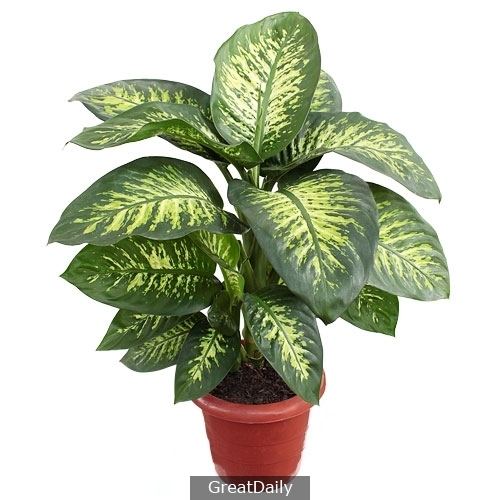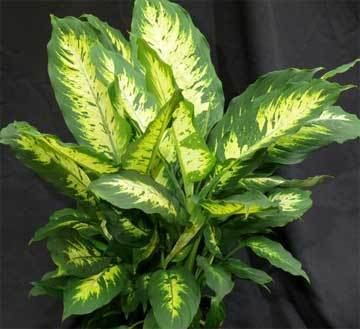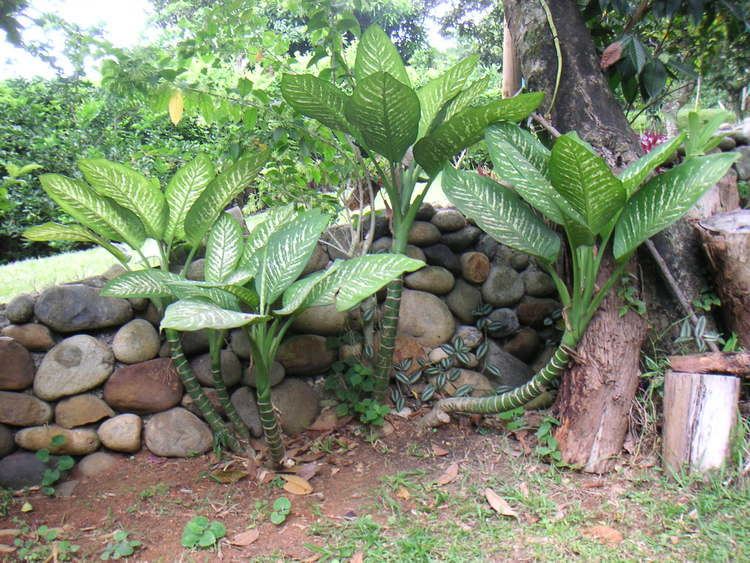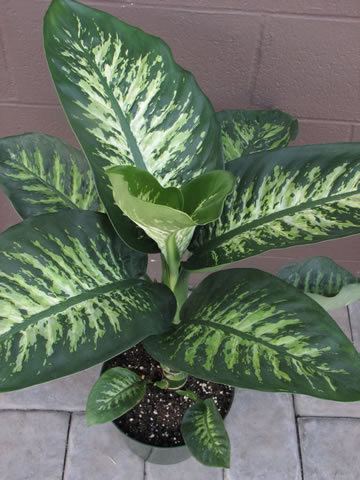Name Dieffenbachia(Plant) Role Plant Scientific name Dieffenbachia | Higher classification Arum | |
 | ||
Lower classifications Dieffenbachia seguine, Dieffenbachia amoena | ||
Dieffenbachia how to cut stems propagate plants
Dieffenbachia is a genus of tropical flowering plants in the family Araceae. It is native to the New World Tropics from Mexico and the West Indies south to Argentina. Some Species are widely cultivated as ornamental plants, especially as houseplants, and have become naturalized on a few tropical islands.
Contents
- Dieffenbachia how to cut stems propagate plants
- Propagating dieffenbachia cuttings from an adult plant
- Species
- Ecology
- Cultivation
- Toxicity
- References

Dieffenbachia is a perennial herbaceous plant with straight stem, simple and alternate leaves containing white spots and flecks, making it attractive as indoor foliage. Species in this genus are popular as houseplants because of their tolerance of shade. Its English names, dumb cane and mother-in-law's tongue (also used for Sansevieria species) refer to the poisoning effect of raphides, which can cause temporary inability to speak. Dieffenbachia was named by Heinrich Wilhelm Schott, director of the Botanical Gardens in Vienna, to honor his head gardener Joseph Dieffenbach (1796–1863).

Propagating dieffenbachia cuttings from an adult plant
Species
The World Checklist of Selected Plant Families lists the following species:

- Dieffenbachia aglaonematifolia Engl. - Brazil, Paraguay; Corrientes + Misiones Provinces of Argentina
- Dieffenbachia antioquensis Linden ex Rafarin - Colombia
- Dieffenbachia aurantiaca Engl - Costa Rica, Panama
- Dieffenbachia beachiana Croat & Grayum - Costa Rica, Panama
- Dieffenbachia bowmannii Carrière - Colombia, northwestern Brazil
- Dieffenbachia brittonii Engl. - Colombia
- Dieffenbachia burgeri Croat & Grayum - Costa Rica
- Dieffenbachia cannifolia Engl. - Colombia, Ecuador, Peru
- Dieffenbachia concinna Croat & Grayum - Costa Rica, Nicaragua
- Dieffenbachia copensis Croat - Panama
- Dieffenbachia cordata Engl. - Peru
- Dieffenbachia costata Klotzsch ex Schott - Colombia, Ecuador, Peru
- Dieffenbachia crebripistillata Croat - Panama
- Dieffenbachia daguensis Engl. - Colombia, Ecuador
- Dieffenbachia davidsei Croat & Grayum - Costa Rica
- Dieffenbachia duidae (Steyerm.) G.S.Bunting - Venezuela, Guyana
- Dieffenbachia elegans A.M.E.Jonker & Jonker - Bolivia, northwestern Brazil, the Guianas
- Dieffenbachia enderi Engl. - Colombia
- Dieffenbachia fortunensis Croat - Panama
- Dieffenbachia fosteri Croat - Panama
- Dieffenbachia fournieri N.E.Br. - Colombia
- Dieffenbachia galdamesiae Croat - Panama
- Dieffenbachia gracilis Huber - Peru, northwestern Brazil
- Dieffenbachia grayumiana Croat - Costa Rica, Panama, Colombia
- Dieffenbachia hammelii Croat & Grayum - Costa Rica, Nicaragua
- Dieffenbachia herthae Diels - Ecuador
- Dieffenbachia horichii Croat & Grayum - Costa Rica
- Dieffenbachia humilis Poepp. - Bolivia, Peru, Ecuador, northwestern Brazil, the Guianas
- Dieffenbachia imperialis Linden & André - Peru
- Dieffenbachia isthmia Croat - Panama
- Dieffenbachia killipii Croat - Panama
- Dieffenbachia lancifolia Linden & André - Colombia
- Dieffenbachia leopoldii W.Bull - Colombia
- Dieffenbachia longispatha Engl. & K.Krause - Honduras, Nicaragua, Costa Rica, Panama, Colombia, Venezuela
- Dieffenbachia lutheri Croat - Panama
- Dieffenbachia macrophylla Poepp. - Peru
- Dieffenbachia meleagris L.Linden & Rodigas - Ecuador
- Dieffenbachia nitidipetiolata Croat & Grayum - Panama
- Dieffenbachia obliqua Poepp. - Peru
- Dieffenbachia obscurinervia Croat - Panama
- Dieffenbachia oerstedii Schott - southern Mexico (Veracruz, Tabasco, Campeche, Oaxaca, Chiapas), Central America (all 7 countries), Colombia
- Dieffenbachia olbia L.Linden & Rodigas - Peru
- Dieffenbachia paludicola N.E.Br. ex Gleason - northwestern Brazil, the Guianas, Venezuela
- Dieffenbachia panamensis Croat - Panama
- Dieffenbachia parlatorei Linden & André - Colombia, Venezuela
- Dieffenbachia parvifolia Engl. - northwestern Brazil, Bolivia, Ecuador, Peru, Venezuela
- Dieffenbachia pittieri Engl. & K.Krause - Panama
- Dieffenbachia seguine (Jacq.) Schott - West Indies, south to Brazil and Bolivia
- Dieffenbachia shuttleworthiana Regel - Colombia
- Dieffenbachia standleyi Croat - Honduras
- Dieffenbachia tonduzii Croat & Grayum - Nicaragua, Costa Rica, Panama, Colombia, Ecuador
- Dieffenbachia weberbaueri Engl. - Peru
- Dieffenbachia weirii Berk. - Colombia
- Dieffenbachia wendlandii Schott - southern Mexico (Querétaro, Veracruz, Oaxaca, Chiapas) south to Panama
- Dieffenbachia williamsii Croat - Bolivia
- Dieffenbachia wurdackii Croat - Peru
Ecology

In a survey which began in 1998, researchers in Costa Rica noticed that the strawberry poison frog Oophaga pumilio, deposited almost all (89%) of their tadpoles on the leaf axils of Dieffenbachia. As a result, the frog population fluctuated with the abundance of Dieffenbachia, especially in secondary forest. A majority of the plants were eradicated by 2012 when the surveyors returned to the same area, with only 28% of 2002 plant numbers remaining. Researchers concluded that the reason for the rapid decline in Dieffenbachia was due to increased abundance of the collared peccary Pecari tajacu in the La Selva Biological Station research area; a small pig-like animal which feeds on Dieffenbachia and other plants.
Cultivation
With a minimum temperature of 5 °C (41 °F), dieffenbachia must be grown indoors in temperate areas. They need light, but filtered sunlight through a window is usually sufficient. They also need moderately moist soil, which should be regularly fertilized with a proprietary houseplant fertilizer. Leaves will periodically roll up and fall off to make way for new leaves. Yellowing of the leaves is generally a sign of problematic conditions, such as a nutrient deficiency in the soil. Dieffenbachia respond well to hot temperatures and dry climates.
The Dieffenbachia prefers medium sunlight, moderately dry soil and average home temperatures of 62–80 °F (17–27 °C). Most require water about twice a week. As Dieffenbachia seguine comes from the tropical rain forest, it prefers to have moisture at its roots, as it grows all the time, it needs constant water, but with loose well aerated soils.
Toxicity
The cells of the Dieffenbachia plant contain needle-shaped calcium oxalate crystals called raphides. If a leaf is chewed, these crystals can cause a temporary burning sensation and erythema. In rare cases, edema of tissues exposed to the plant has been reported. Mastication and ingestion generally result in only mild symptoms. With both children and pets, contact with dieffenbachia (typically from chewing) can cause a host of unpleasant symptoms, including intense numbing, oral irritation, excessive drooling, and localized swelling. However, these effects are rarely life-threatening. In most cases, symptoms are mild, and can be successfully treated with analgesic agents, antihistamines, or medical charcoal. Gastric evacuation or lavage is "seldom" indicated. In patients with exposure to toxic plants, 70% are children younger than 5 years.
Stories that Dieffenbachia is a deadly poison are urban legends.
